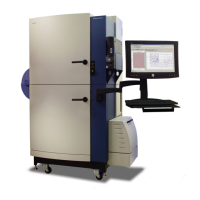FLIPR
®
Tetra High Throughput Cellular Screening System User Guide
0112-0109 H 241
the same time. Plates should be arranged to minimize potential
interactions between the plate handler and the pipettor. The following
guidelines may be helpful in assigning plate positions for automation:
Open reservoirs with very large wells cannot be handled by the plate
handler. These plates must be placed in the instrument manually prior
to entering manual mode. Replacing these plates will require the user
to halt remote control and place the instrument in manual mode to
manually replace or refill the reservoir. Deep well plates are a good
alternative to using these plates.
If tips will be loaded in the experiment, they must be assigned to the
Source Plate 1 location. When tips are assigned to this position, the
position cannot be used for source plates. Unless the tips are going to
be changed for every plate, it is a good idea to load the tips prior to
placing the instrument into remote mode. Alternatively, the user could
create a tip configuration protocol which will load and wash the tips.
This assay can be run and then the empty tip rack can be removed by
the robot to allow the source 1 position to be used for other plates. As
of v1.1 of the automation interface, tip loading and tip washing is
available.
Plates which will be switched frequently should be placed closer to the
left side of the instrument (near the automated landing pad) than
plates which are not switched frequently.
Deep well plates (or reservoirs) which may be used for a series of
assays before being replaced may be placed in the source 3 location, as
long as it is not being used for Cell Reservoir. This will minimize the
interaction between the pipettor and the plate handler when switching
plates during the majority of assays.
It is only possible to RESET the instrument if a tip rack is present in the
instrument. A RESET is required if the instrument enters a fault
condition. If automated recovery from fault conditions is desired, the
tips/source 1 position should be used for tips only and an empty tip
rack should be left in this position at all times.
Data File Name settings
Configure the desired data file name in the Data File Name group box.
If the Include Bar Code box is checked, the bar codes for all of the
plates which have been checked as requiring them will be included in
the data file name. Bar codes will be separated by an underscore (_). If
a bar code cannot be read, or one has not been provided during the
loadplate command, the software will record Bad_bar_code.
The settings for the data file name are ignored in remote mode when
the data file name is included with the runexperiment command line.
Care should be taken when using this command to ensure that data file
names are always unique to prevent the overwriting of data files.
If the ScreenWorks Software is allowed to create the data file name, it
will always end in _###.fmd, where ### is the plate number with this

